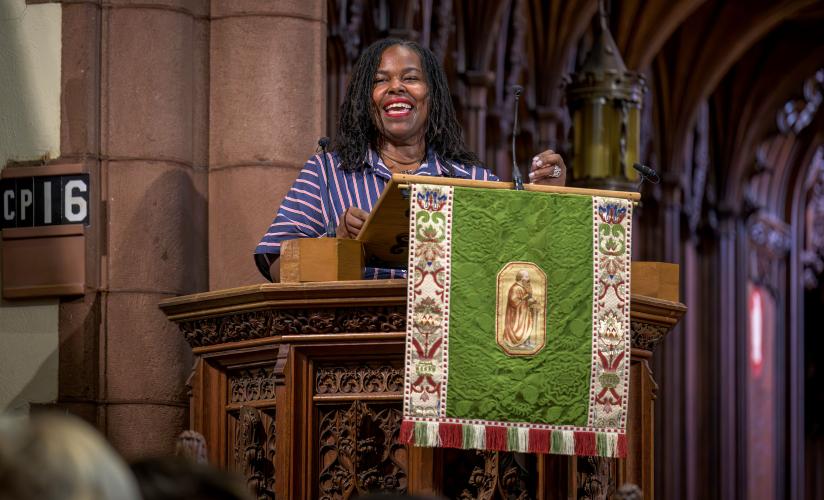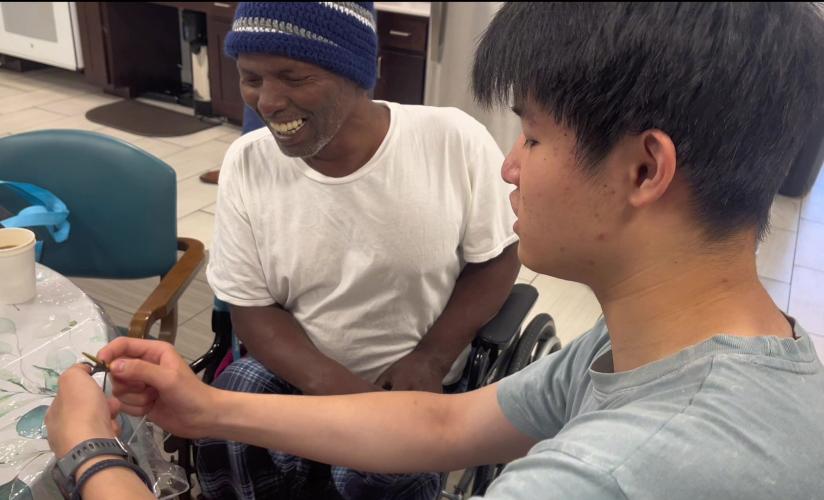

Students and faculty reflect on Spring Break trip to civil rights sites.
BY KRISTIN DUISBERG
As they crossed the Edmund Pettus Bridge in Selma, Alabama, on Sunday, March 5, nine St. Paul’s School students who had traveled there as part of the School’s inaugural civil rights-focused Spring Break Trip experienced a range of emotions. Excitement. Awe. Sadness. Elation. Almost 58 years to the day after a young activist named John Lewis had led 600 Black citizens to the same bridge in pursuit of the right to vote, only to be met with police brutality, the students and their three SPS chaperones felt their own footsteps on the bridge and heard the hum of hundreds of voices as they immersed themselves in a crowd of individuals of every race, age and identity.
“Seeing all those people together walking, and actually experiencing it for ourselves — it’s something that’s just stuck with me,” says Maya Lokhandwala ’25.
“We learned about Selma and the violence that happened there in Hum 4,” adds Jenny Jang ’24, “but it doesn’t sink in the same way when you’re just reading and taking notes and having some class discussion. To be learning about history in the places where it took place … the knowledge has stayed with me in a completely different way.”
That profound personal connection was exactly what Rev. Charles Wynder, the School’s dean of chapel and spiritual life, had hoped students would take away from the weeklong trip when he came up with the idea for what he describes as “a pilgrimage for history, justice and healing” last fall. Joined by Dr. John Bassi, P’17,’19,’21, the School’s medical director; and Humanities Teaching Fellow Lauren Lamb, Wynder led a group that also included Raen Kao ’24, Gabriella Purvis ’24, John Sanfilippo ’25, Cole Edwards ’24, Cora Partridge ’24, Jermaine Baffour ’24 and Isabella Martinez ’24. In Selma, Montgomery and Birmingham, Alabama, and in Atlanta, the group visited historic sites, museums and memorials to the struggle for — and the celebration of — civil rights and racial equality in America’s Deep South.
In Atlanta, the group met with Dr. Catherine Meeks, executive director for the Absalom Jones Center for Racial Healing; toured Morehouse and Spellman Colleges and visited historic Ebenezer Baptist Church, the King Center — dedicated to the memory of Martin Luther King Jr. — and the National Center for Civil and Human Rights. In Montgomery, the group toured the Southern Poverty Law Center, had a brief private audience with U.S. Assistant Attorney General for Civil Rights Kristen Clarke, and visited the National Memorial for Peace and Justice. The group’s time in Birmingham included a tour of the 16th Street Baptist Church, where four young Black girls were killed in a racially motivated bombing in 1963, and the Civil Rights Institute.


In between stops, there was plenty of journaling, good food and music, and an opportunity for students to get to know one another in ways they hadn’t before. For some participants, the destinations had personal resonance. Martinez, who is interested in public policy and issues around justice and healing, was struck by the role of women in the civil rights movement. For Edwards, the experience of visiting the National Memorial for Peace and Justice in Montgomery, a destination broadly referred to as the Lynching Museum, hit close to home. “Wake County, North Carolina, had 55 lynching victims. My father grew up in Wake County in the sixties,” he says. “So these could have been people that he knew, that his siblings knew, that his parents knew.”
Wynder says he was moved by the grace and courage with which students engaged with the Lynching Museum in particular, and the experience as a whole. “They did great head and heart work,” he says, “and were wonderful ambassadors for St. Paul’s School.”
In turn, they credit him with understanding how to keep the emotional intensity at just the right pitch. “He provided so much insight and knowledge about the events,” Lokhandwala says. “We were there with a purpose, and he explained everything.” Adds Martinez, “His insights helped us make meaning of what we were seeing and learning, and his dedication to the experience for all of us just made the trip so much better.”
As a Teaching Fellow, Lamb found it a powerful exercise in how to discuss difficult information with high school-aged students. “As a Humanities teacher, one of my main challenges in the classroom is condensing a lot of information, making it digestible, and knowing when it’s appropriate to share challenging things,” she says. “So I appreciated that these students were willing and wanting to engage with a history that is hard to see and hard to hear about.” The experience was also, she says, an example of the School mission as a lived experience. “I found myself thinking about how this trip was hopefully giving [these students] the context and the knowledge to be inspired to do good things for others and not just for [themselves].”
Wynder’s pilgrimage of history, justice and healing may have been a first of its kind for SPS, but it will not be the last. There are plans to do the trip again in 2024, and Wynder says discussions are already underway to think about how to integrate it more fully into the life of the School and the Humanities curriculum. He’s hopeful that the next trip will include a service-learning component, most likely in Atlanta.



